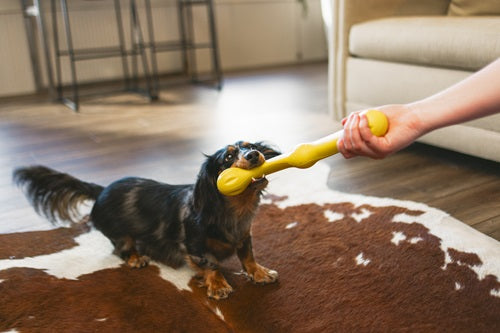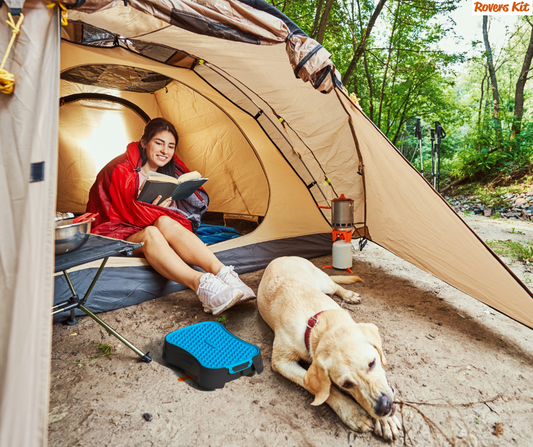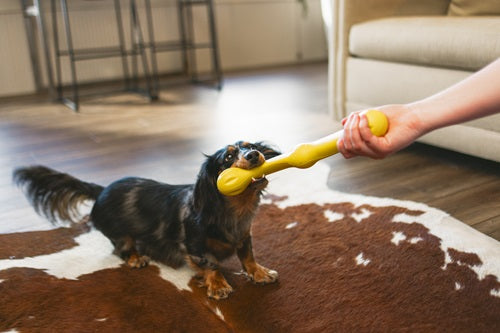Playing with your dog is always fun. You strengthen the bond with your dog and it makes both the dog and you as the owner happy. Playing in general is one of the most bond-strengthening activities you can do with your dog. There is a lot of social contact and you work on trust. So playing with your dog has a really important function for the well-being of the dog. It provides both physical and mental stimulation. There are all kinds of games you can play with your dog, but this blog is especially about tugging games.
A tugging game is a game in which both the dog and you as the owner each hold the toy on one side and pull it. Dogs among themselves can also play this game by pulling both on one side of a toy.
Often we get questions such as, does tugging games make my dog aggressive or do I always have to win the tugging game. And for people with a hunting dog, we often hear that they are afraid that the dog will bite too hard and then it is no longer good for hunting. There they must have a so-called soft bite in order not to destroy the prey. We can actually answer all of the above questions with “no”.
Dogs don't get aggressive from tugging games, but it is important to pay attention to how they are played. See the explanation later in this blog. You certainly don't always have to win the game. This was indeed often said during training, but if you always lose then the game is no longer fun and playing should be fun. That is why it is good to have a good balance in it. Sometimes you win and sometimes the dog wins. That makes the game fun.
For hunting dogs, tugging games are also certainly good. They can learn very well when to bite hard and when not to. Fetch games (a toy is thrown away and the dog fetches and brings it back) is an example where you learn not to pull and therefore to deal more gently with what you have in your mouth.
With tugging games you can also give the dog the commands "hold" and "release" in a very playful and fun way. And this has the advantage that you can use this well in all kinds of other circumstances. So you can also make it a fun exercise.
For many dogs, you can certainly use a tugging game as a reward for good behavior. Playing together is really one of the best things for the dog to do together, so it is certainly seen as a reward by the dog. So a tugging game has many functions. Any dog of any age and breed can certainly enjoy a tug-o-war game safely.
But what is important in tugging games and how do you teach your dog good tugging game?
Tugging games increase the excitement of the dog. It is important not to let this arousal run too high as it can lead to stress or aggression in some dogs. So it is certainly not standard aggression enhancing, but with certain dogs (especially if there is already a lot of stress), you should stop earlier with a tugging game to prevent aggression. Playing a tug game well teaches the dog (and the owner) to stop just in time and to prevent aggression from flaring up.
A tugging game is not intended to be a competition. It must continue to play. That is why it is important to give your dog e.g. also occasionally hold the tugging game yourself without tugging it directly. You will see that the dog then offers the toy to you to continue playing. This is “teamwork” and you invite each other.
It is also important that you “teach” your dog the tugging game and provide good toys that you can use. Certainly in the learning phase it is important that there are so-called rules for tugging games.
Type of tug-o-war toy:
To prevent the dog from biting you on the hands, it is wise to choose a toy where the distance between your hands and the dog's mouth is large enough. Most dogs really don't bite your hands on purpose while tugging, but when the excitement is too high they may get too close to your hands. To prevent this, you can play with the West Paw Bumi®, for example or the West Paw Zwig® or the West Paw Skamp®.
With the Skamp® your hands are already a bit closer to the mouth of the dog, but there is still enough distance and you can also switch to another end with your hand:

|
 |
 |
| Bumi | Zwig | Skamp |
All these toys ensure that there is enough distance between the mouth of the dog and your hands and so pulling together also remains fun. Of course there are several toys to think of that give this distance, such as e.g. a ball in a sock or e.g. a sturdy plush toy like the West Paw Rowdies. They are made for "rough" play.
If you play too rough, you stop playing. With this you clearly indicate to your dog that you no longer like that game. It is important that you end playing in a fun way for your dog and therefore do not get angry. For example, you can choose to let go of the toy yourself and no longer accept the invitation to play. This indicates that you no longer like the game and therefore quit. After a few minutes you can try again and then you keep playing yourself shorter than the time before, so that you stop before the dog gets too aroused. You then finish the game with e.g. something tasty (you exchange for the tugging game and then you put the tug-o-ware toy away).
Practical Tips for tugging games:
• It is best to have 2 or more tugging games nearby. This has the advantage that you can possibly exchange for another game. You can practice the “loose” and “hold” by swapping for another tug—ware toy.
• Depending on how enthusiastic your dog is, encourage your dog as well. This teaches them that they are doing well, but then it also sounds like playing.
• If you notice that your dog is getting too excited or finds it too exciting, try sitting on the floor / stool yourself and then tug on the toy. This is often more relaxed for the dog than when you are bent over the dog and pull the toy.
• Do not shake the toy yourself too hard and keep the toy at the height of the dog or move it over the ground. Especially with puppies / adolescents who are still growing, it is better not to shake the tug-o-war toy too much back and forth. You could even injure your dog with this. By keeping the toy on the level of the dog, you prevent them from jumping at the toy and injuring themselves. Keep a light tension on the toy, but try to avoid pulling too hard. This gives your puppy / adolescent more self-confidence.
• Also for senior dogs with e.g. osteoarthritis it is important not to move too much from right to left. Let the dog take the initiative and then follow it a bit. When playing hurts, the dog will often attach this to you and doesn’t want to play the tugging game with you. They think that playing with you hurts and then they want to play with you less. Trust is then damaged.
• With puppies that still have to change teeth, it is important to choose good material for tugging games. A floss rope can then e.g. are too painful, because they can get stuck in this with their teeth and that hurts. As a result, playing is no longer fun. So choose good material that also matches the age phase.
• Avoid playing on a slippery floor. Better to play on a carpet or outside on the grass. This prevents injuries and unpleasant experiences.
• Include pauses and don't play too long. Sometimes 5 or 10 minutes is long enough. And it can help to use some kind of start and stop signal. But you can also use “hold” and “loose” for this.
• Regularly take the initiative yourself, by calling your dog to play a tugging game together and also regularly accept the invitation of your dog when he comes to you with a toy. Alternate this.
• Move the toy over the ground and walk backwards. Most dogs will definitely come after you and want to play.
Written by Rita Viel, Export manager from West Paw and certified dog trainer and dog behaviourist in The Netherlands









